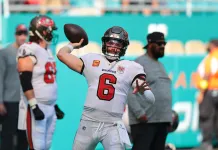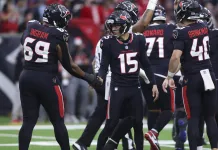NFL Week 10 Model Projections & Strength Ratings
This is part of a recurring series on VSiN.com in which VSiN host Jonathan Von Tobel tracks the progress of a model he created for the NFL season
Week 9 Best Bets: 1-4 | Overall Best Bets 22-23
Week 9 Overall: 6-8 | Overall Record: 73-61-2
Week 9 Recap
Once again Jon Von Model took it on the chin, although overall edges did much better than the previous week. Its biggest edges went 1-4 and over the last three weeks the five plays we use for the contest are 4-11 which brings us down to 22-23 for the season.
If you exclude the biggest edges the other sides got you to 5-4 for the week which is perfectly fine, but clearly the model that I had created for this season has run its course. So, what do we do from here?
We rebuild!
Week 10 Adjustments
To move forward we must first go back.
As a quick recap, Jon Von Model was a model built on regression testing. I took eight statistics, assigned the proper statistics to the home and away team from the results and asked Excel how those statistics correlate to a home margin of victory. From there, I took the weighted coefficients, multiplied them by the actual statistical output for both teams, added in homefield and came away with a projected margin of victory at home.
At the beginning of the season it gave us some decent edges, but as the season went along it was clear that this was not the best way to make a predictive model. In my effort to improve the model I went back to my research from the summer; Andrew Mack’s Statistical Sports Models In Excel.
In the chapter when discussing how to compare your model to the benchmark you are trying to achieve Mack writes about regression methods, and linear regression specifically; the entire basis of my original Jon Von Model:
“Multiple linear regression is a very simple modeling technique which describes a target output variable as a function of a number of input variables weighted by various coefficients along with an intercept. It’s so simple in fact that some sports bettors might scoff at the idea of including it in this book.”
Using regression testing can be useful as part of a model, but it should not be the basis of the entire model. That is something that I did incorrectly with this first foray into modeling. The entire first version of Jon Von Model was regression testing and regression testing only. I believe that is why the predictive nature of the model fell off after a hot start.
So, where do we go from here? Well, I had an idea.
In Mack’s book he runs through a litany of different models, starting with a basic model that can eventually evolve over time the more you put into it. I have decided to build a new version of Jon Von Model that begins with this basic version of the model.
This new version of Jon Von Model is called a Bradley-Terry Model (BTM). A BTM is a probability model for the outcome of pairwise comparisons between individuals, teams or objects. As Mack puts it in his book, it is a model that uses game outcomes to produce team ratings that would maximize the probability of producing the results we have seen.
If you’re paying attention to this point then a clear and obvious flaw should stick out to you. If not, I’ll spell it out: This is a model based on game results, and no other metric. There is no drive success rate, pressure rate or any other statistic other than the final game scores in this model.
A model like this will have quite a bit of noise in it, so why use it? Because this will be the base of this version of Jon Von Model that I hope will be accurate and useful by the end of the season. And as you will see shortly, even a basic method like this still turns out some numbers and ratings that are somewhat in line with the market.
Week 10 Ratings & Projections
If you’ve been following this journey all season you will notice a new word in there along with projections; ratings. The best part about converting JVM into a BTM is that we get strength ratings to go with the model projections.
The previous version of JVM did not spit out actual ratings. Instead, I had to go through and manually calculate how the model viewed each team. The BTM is based on ratings derived from the game results, so we get to see the strength ratings of these teams based on the results we have.
An initial glance at the strength ratings from the new version of JVM seem somewhat on point with where the market has these teams rated. Philadelphia is the highest rated team, Arizona is the lowest rated team and the order of the teams in between seem on point.
One surprising result from the strength ratings would be the placement of the Buffalo Bills, which JVM has as the 20th ranked team in the NFL. That is extremely low for a team that is +2000 to win the Super Bowl at DraftKings. By comparison, the New Orleans Saints – a team JVM deems stronger – is +5500 to win the Super Bowl. It would seem we have our first flaw with this simple version of JVM, but let me play the advocate if only for a moment.
The Bills are only 5-4 SU this season, and their 3-6 ATS record shows that the betting market is too high on this team. Is it possible that JVM is actually right? Only time will tell as we adjust this model over the course of the season.
On to the projections!
Those who have been here since the beginning will notice a new format for the projections as well. No longer do the projections come out based on just home margin of victory, but now we have the projected spread for each team according to JVM. The process has given us some interesting results.
The biggest discrepancies we see from the model projections and the market are with the Jaguars, Vikings, Steelers, Falcons and Seahawks. This simplistic model is projecting some massive edges for these teams. In two of these contests it has the underdog – Jaguars and Vikings – favored and by much more than a field goal for both!
So, what do we do with these projections?
Frankly, we should do nothing. This new version of JVM is based on nothing but the results of the season. It is going to lead to a lot of noise in the projections until we really start to add to the process of the model overall. We will still keep track of the overall edges as the season goes along, but these projections – like the original version of JVM – are nowhere near playable yet.
Next week we will incorporate more into JVM and transform it into what is called a TOOR model, but that explanation will take place next week.
Good luck!





